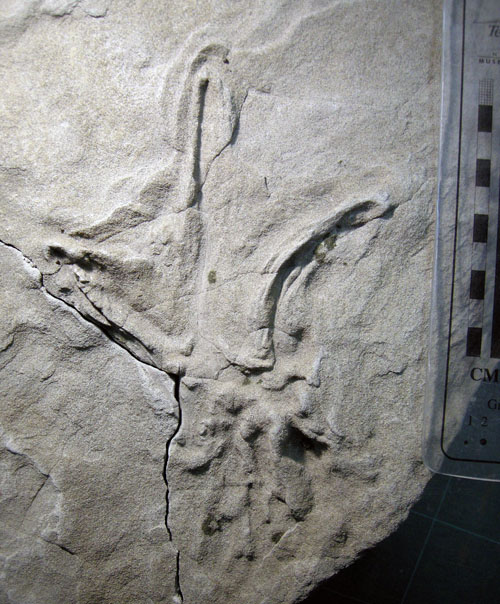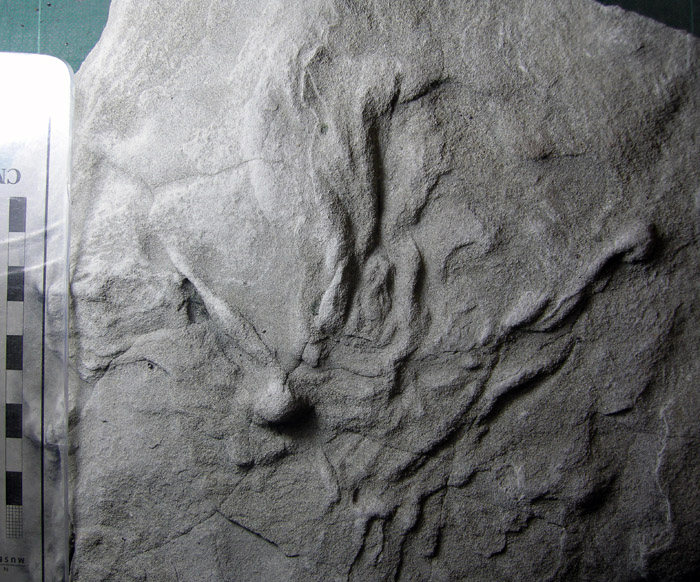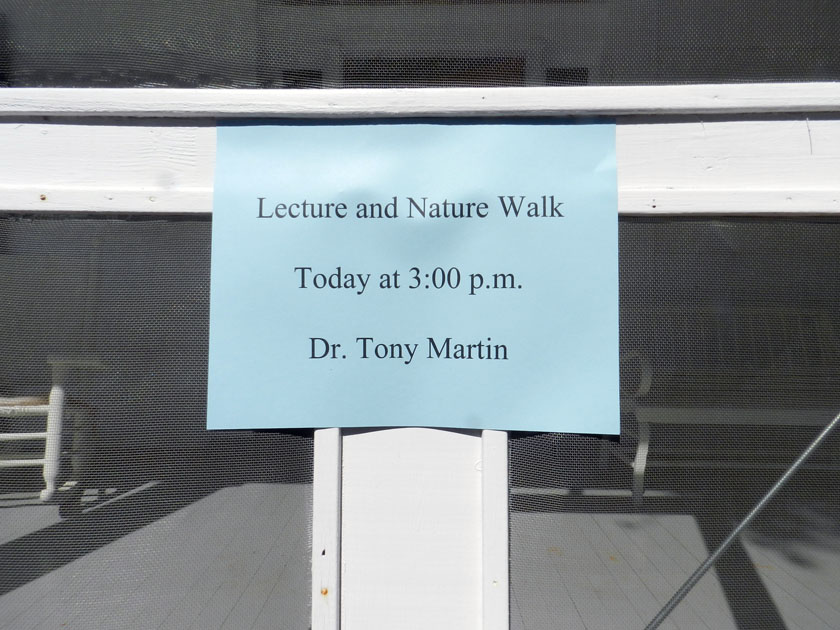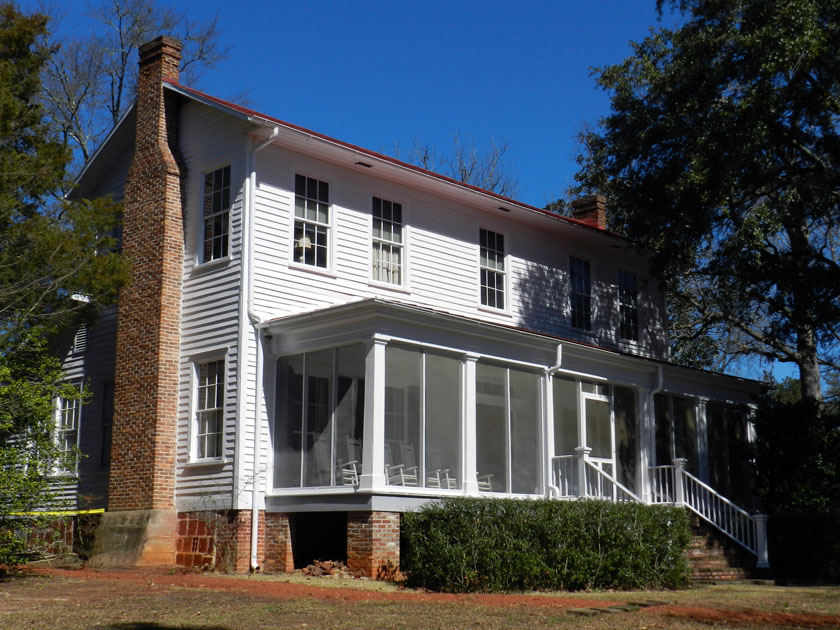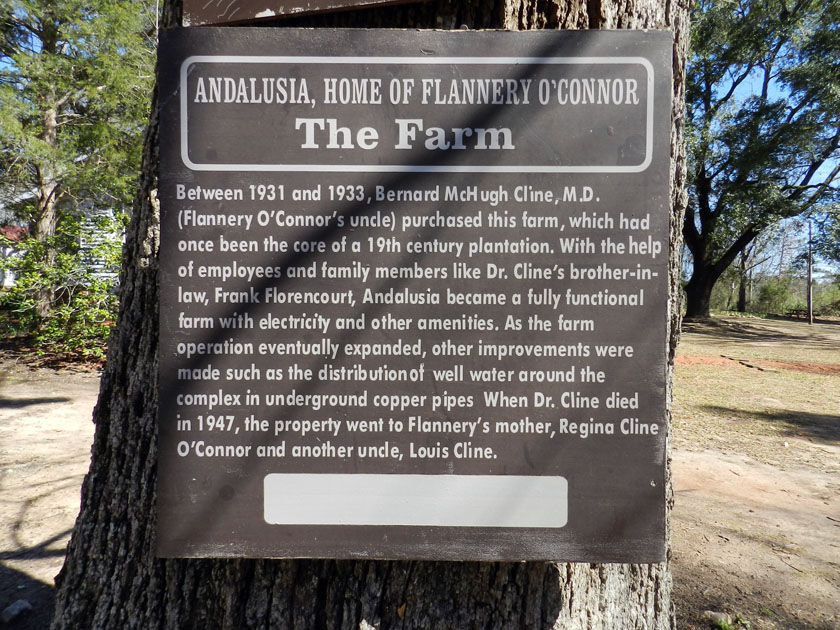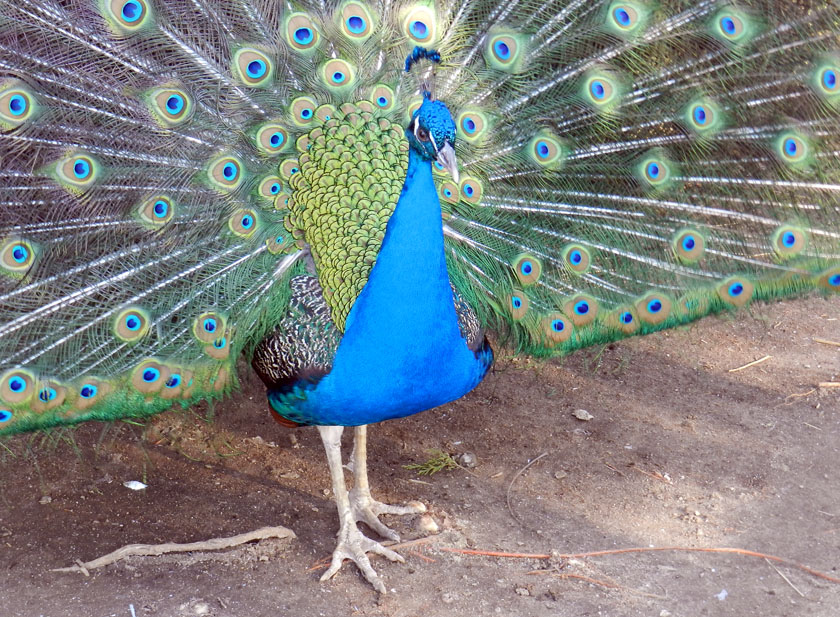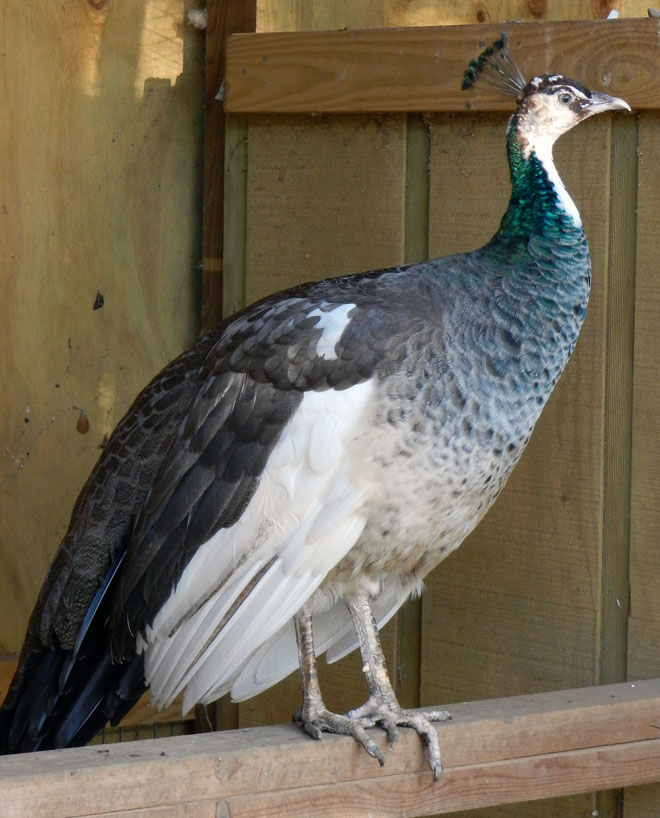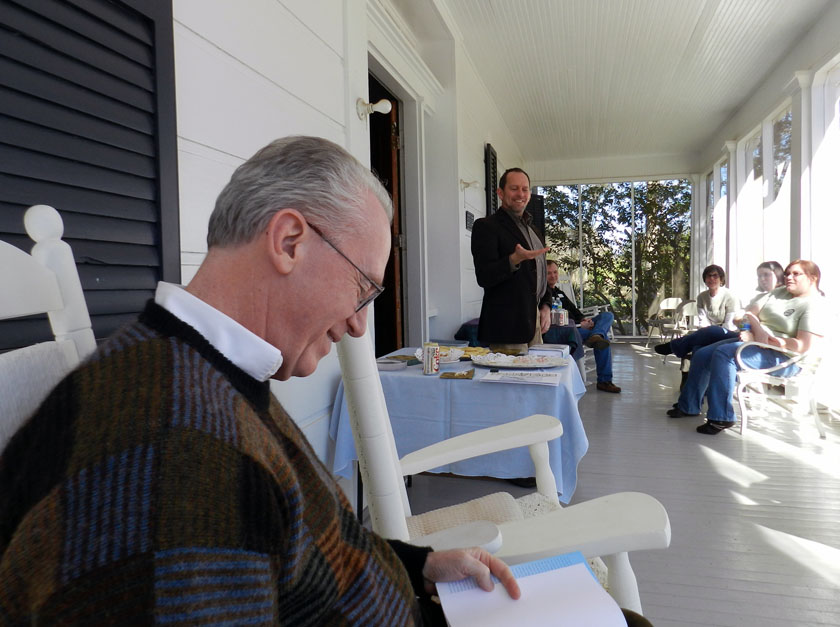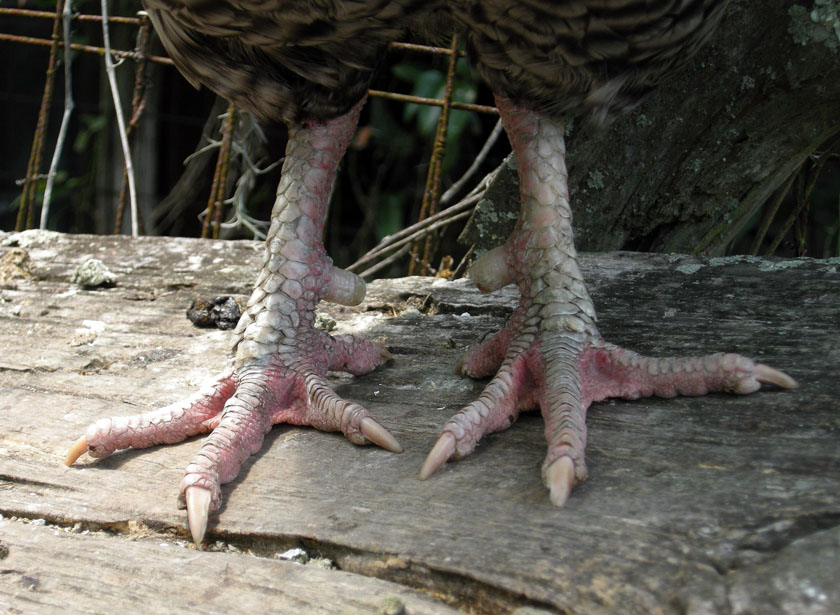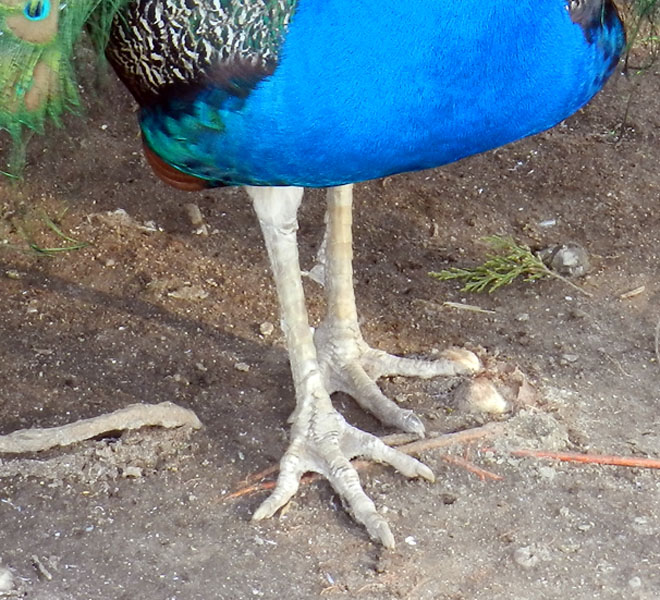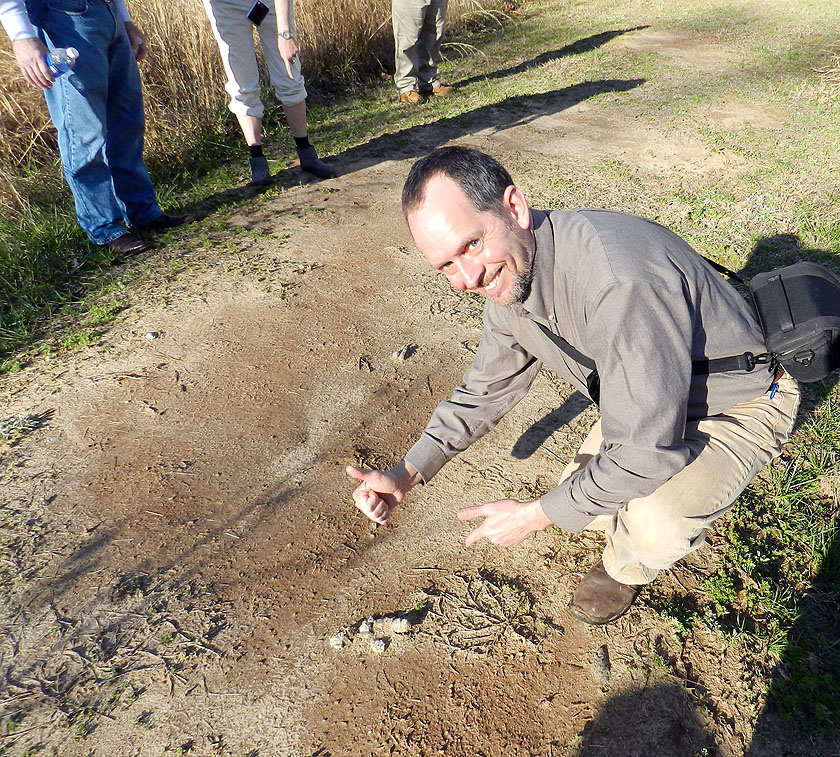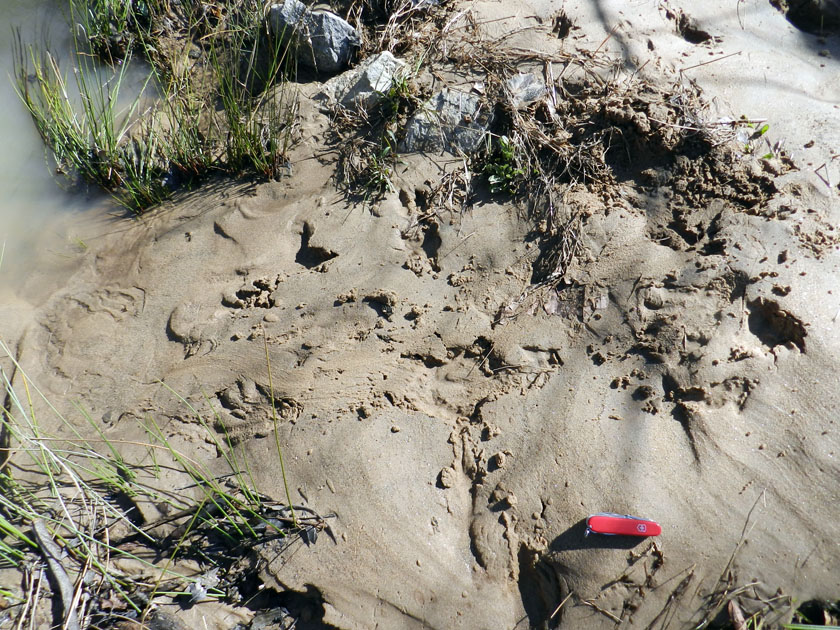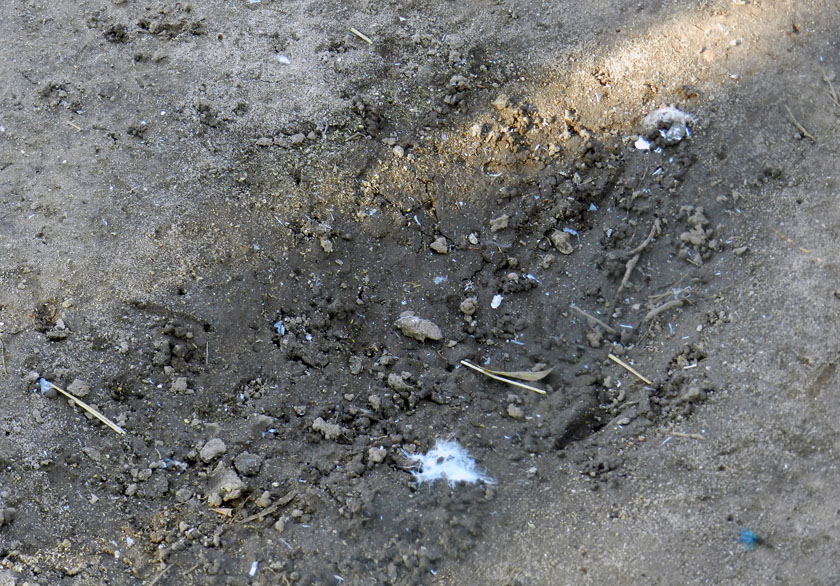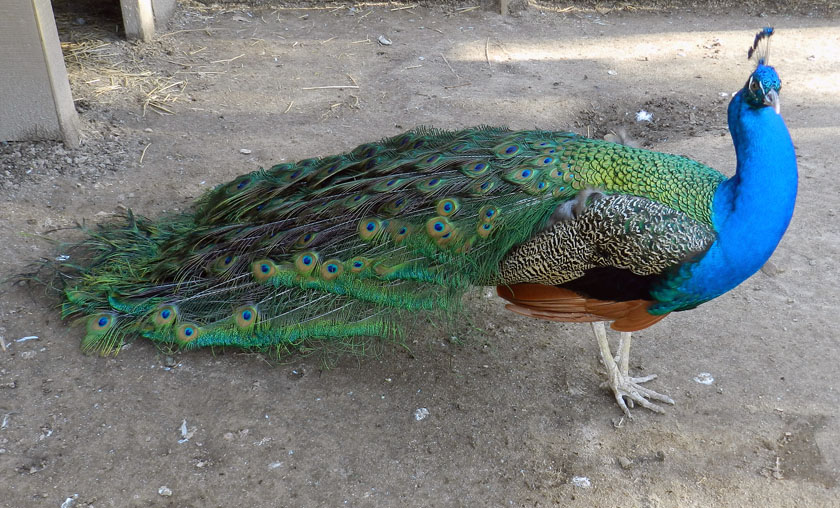The track seemed familiar, like a face I had seen before but couldn’t quite identify. Then I realized who it belonged to, and where I had seen many others like it. It was a bird track, remarkably similar to those in the sands and muds of the Georgia coast, made daily by the herons, egrets, and shorebirds. The other two tracks near it were similar in size and shape, but not nearly as evocative as this one. This footprint conjured an image of a bird slowing its descent from flight, then abruptly halting, planting its feet on a moist, sandy surface.
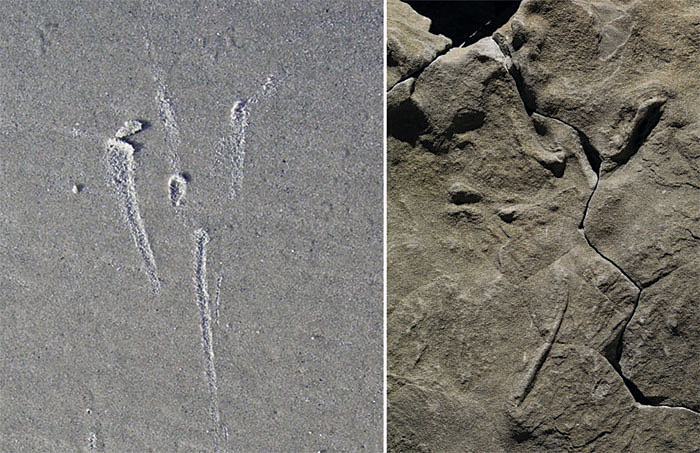 Footprints of flying birds, separated by 10,000 miles and more than 100 million years. The track on the left is from a great egret (Ardea alba), which landed on a hard-packed fine-grained sand of a coastal beach on Jekyll Island, Georgia. The track on the right is from a similarly sized bird that landed on a moist, loose fine-grained sand of a polar river floodplain during the Early Cretaceous Period, in a place now called Dinosaur Cove, Victoria, Australia. Oh yeah, it’s also one of two of the oldest bird tracks in Australia. (Both photographs by Anthony Martin; each track is about 10 cm (4 in) wide.)
Footprints of flying birds, separated by 10,000 miles and more than 100 million years. The track on the left is from a great egret (Ardea alba), which landed on a hard-packed fine-grained sand of a coastal beach on Jekyll Island, Georgia. The track on the right is from a similarly sized bird that landed on a moist, loose fine-grained sand of a polar river floodplain during the Early Cretaceous Period, in a place now called Dinosaur Cove, Victoria, Australia. Oh yeah, it’s also one of two of the oldest bird tracks in Australia. (Both photographs by Anthony Martin; each track is about 10 cm (4 in) wide.)
Except this track was from a vastly different time, place, environment, and climate from the modern-day Georgia coast. It was fossilized in an Early Cretaceous (105-million-year-old) sandstone and collected from the coast of Victoria, Australia, at an auspiciously named spot called Dinosaur Cove. Because Australia was close to the South Pole then, this track and the other two near it were made in a polar environment. The environment was not coastal, either, but the sandy floodplain of a river valley shaped by melt-waters that flowed with each spring thaw.
Even more incongruously, I first saw this track and its petrified companions in the basement of Museum Victoria in downtown Melbourne, Australia, a thriving, cosmopolitan city of more than 4 million just outside the quietude I was experiencing then. Mentally and physically, I was about as far away from the Georgia coast as I could be, rendering the track’s familiarity both jolting and eerie.
 A closer look at this fossil track, made by the right foot of a descending bird about 105 million years ago. Try to match the following verbal description with what you see here. (Photograph by Anthony Martin; scale to the left in centimeters.)
A closer look at this fossil track, made by the right foot of a descending bird about 105 million years ago. Try to match the following verbal description with what you see here. (Photograph by Anthony Martin; scale to the left in centimeters.)
It had four thin toe impressions, like a slightly askew “peace” sign, with three forwardly pointing and spread widely, and one pointing behind. A linear claw mark – nearly as long as the three-toed part of the footprint – corresponded with the rearward-pointing toe, which had also left a faint impression. Sand piles only millimeters high were in front of the other three digits; another small mound of sand in the center toe impression was neatly bisected by a claw mark from that digit. This central claw mark was a trace of its next step, in which it pushed against the sand with the bottom of its foot and cut through the resulting hillock as its foot retracted. The forward toes made for a foot length slightly greater than the fingers on my hands, so it was about the right size for a small heron- or egret-like bird.
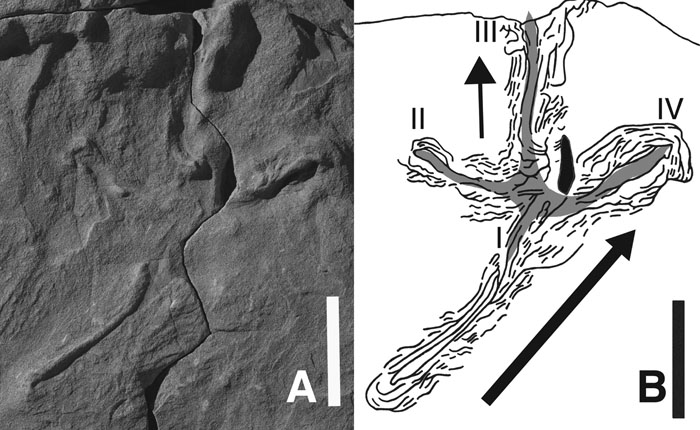
A more analytical look at this track. (A) Photograph showing how it looks on the sandstone surface, along with some of the little hills and valleys associated with it. (B) Interpretative drawing, showing: each digit, labeled from I (hallux) to IV; an approximation of the foot’s overall form (gray outline), the structures around and in the track, the main direction of movement by the foot as the bird landed (big arrow), and the direction of movement taken by that foot in its next step (little arrow). (Both photo and drawing by Anthony Martin; scale bar in both figures = 5 cm (2 in).)
The long, linear claw mark behind most of the track was the primary clue to both its identity and behavior. This was from a hallux, which in humans is our “big toe,” (digit I). But in birds, it is the backward-pointing toe of those that perch, a trait that better allows them to grasp branches in trees. Earlier that year (2011), I had told Tom Rich – a vertebrate paleontologist at Museum Victoria – that the thin-toed theropod dinosaur tracks we discovered in rocks just east of Dinosaur Cove in 2010 were likely not made by birds because they all lacked this identifying feature. Although Cretaceous bird tracks identified elsewhere in the world (Canada, the U.S., Korea, and China) do not always have a hallux, its absence makes it much more challenging to separate these tracks from those of similar looking non-avian dinosaurs.
Yet it was not just the hallux impression that convinced me of its identity, but its lengthiness. This mark was not a mere anatomy lesson, but also a window into what that bird was doing one day 105 million years ago, which was flying. The then-soft, wet sand had been sliced by the sharp claw on the hallux, which contacted the sand first before the rest of the foot registered. As this toe slid forward and stopped, the other digits came down, and forward momentum caused their leading edges to push against the sand, mounding it in front of these toes.
For those of you who saw my previous post about modern bird landing tracks (here), you probably watched this slow-motion video of a sparrow landing and taking off, and you probably watched it twice, because it’s just so stunningly beautiful. Regardless of whether you’ve watched it or not, view it one more time, then look at my interpretative drawing below to see how the same landing movement can be applied to a larger, heron-sized bird, and in a moist sand.
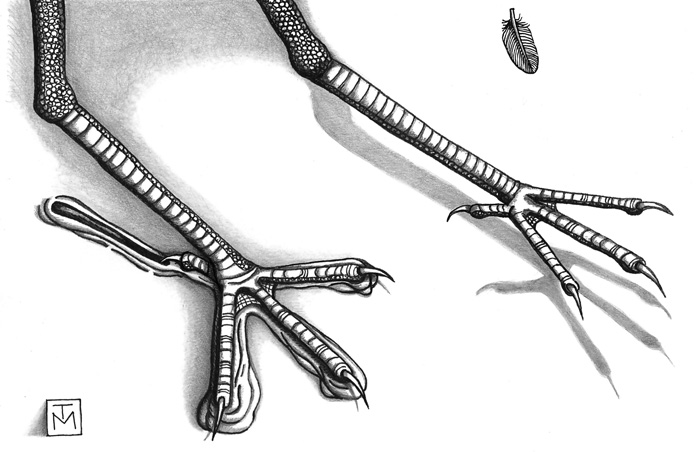 In this partly interpretive, partly speculative drawing, I’m trying to show how the right foot of a heron-like bird, combined with its behavior and a wet, sandy substrate, could have caused the primary features in the Early Cretaceous bird track from Dinosaur Cove. Because the left footprint is not preserved in the rock, I’m assuming that it landed ahead of the right foot. As a result, it is shown here not quite landing, just a fraction of a second behind the right foot, and only represented in my mind by an imagined shadow. So what’s with the feather? Hey, I’m an artist, too. Feel free to find your own meaning in that, preferably aided by bongos.
In this partly interpretive, partly speculative drawing, I’m trying to show how the right foot of a heron-like bird, combined with its behavior and a wet, sandy substrate, could have caused the primary features in the Early Cretaceous bird track from Dinosaur Cove. Because the left footprint is not preserved in the rock, I’m assuming that it landed ahead of the right foot. As a result, it is shown here not quite landing, just a fraction of a second behind the right foot, and only represented in my mind by an imagined shadow. So what’s with the feather? Hey, I’m an artist, too. Feel free to find your own meaning in that, preferably aided by bongos.
Based on my years of experience with Georgia-coast bird tracks, the qualities of this fossil track were consistent with those in tracks made by similar-sized birds – such as small herons or egrets – that landed after flight. Ichnologists call such traces volichnia (= “flight traces”), which are rare in the fossil record, but abundantly represented in soft substrates today wherever flying birds might live. Some of the most evocative of such traces are left in snow, such as those made by owls preying on small mammals, but look closely for them on beaches or river floodplains, and you will find them. Volichnia thus neatly answer the oft-asked question: why do birds’ tracks suddenly appear?
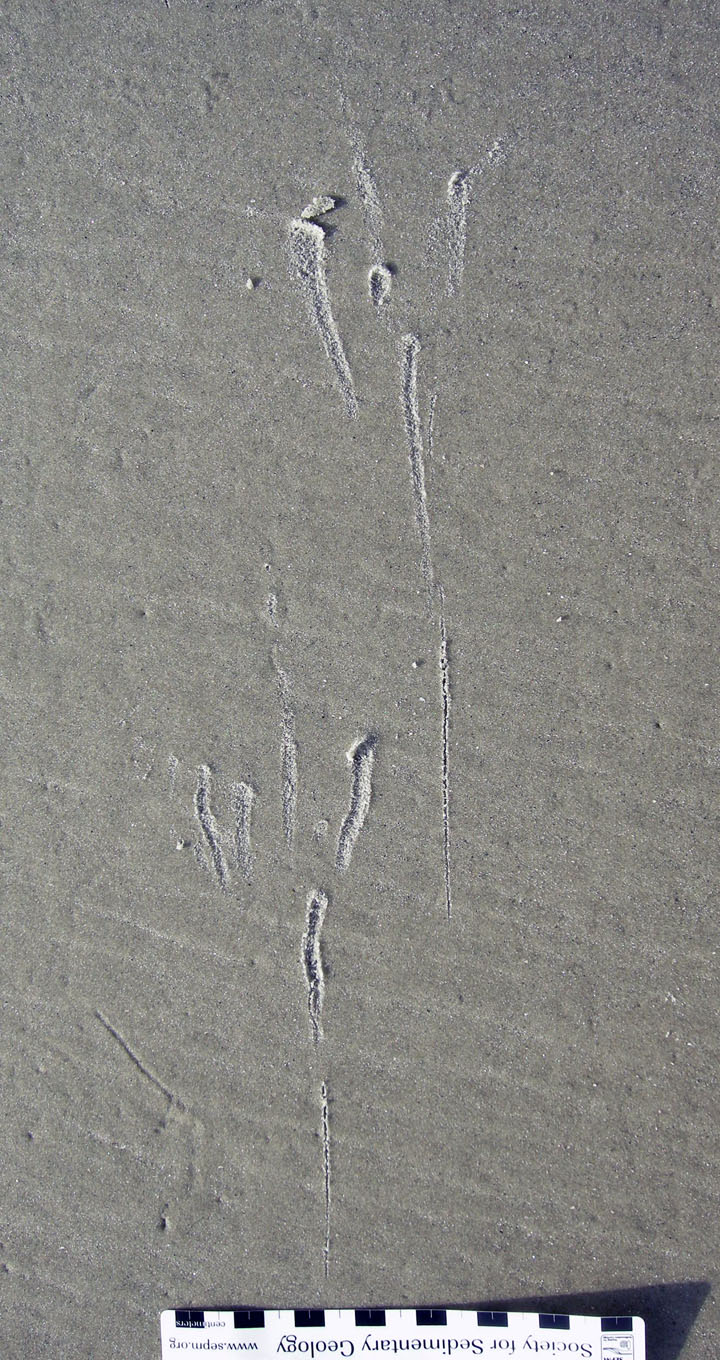 Close-up of great egret tracks made by landing on a hard-packed beach sand, Jekyll Island. Both feet left long hallux claw impressions, although in this instance the left foot preceded the right when landing. (Photograph by Anthony Martin, scale in centimeters.)
Close-up of great egret tracks made by landing on a hard-packed beach sand, Jekyll Island. Both feet left long hallux claw impressions, although in this instance the left foot preceded the right when landing. (Photograph by Anthony Martin, scale in centimeters.)
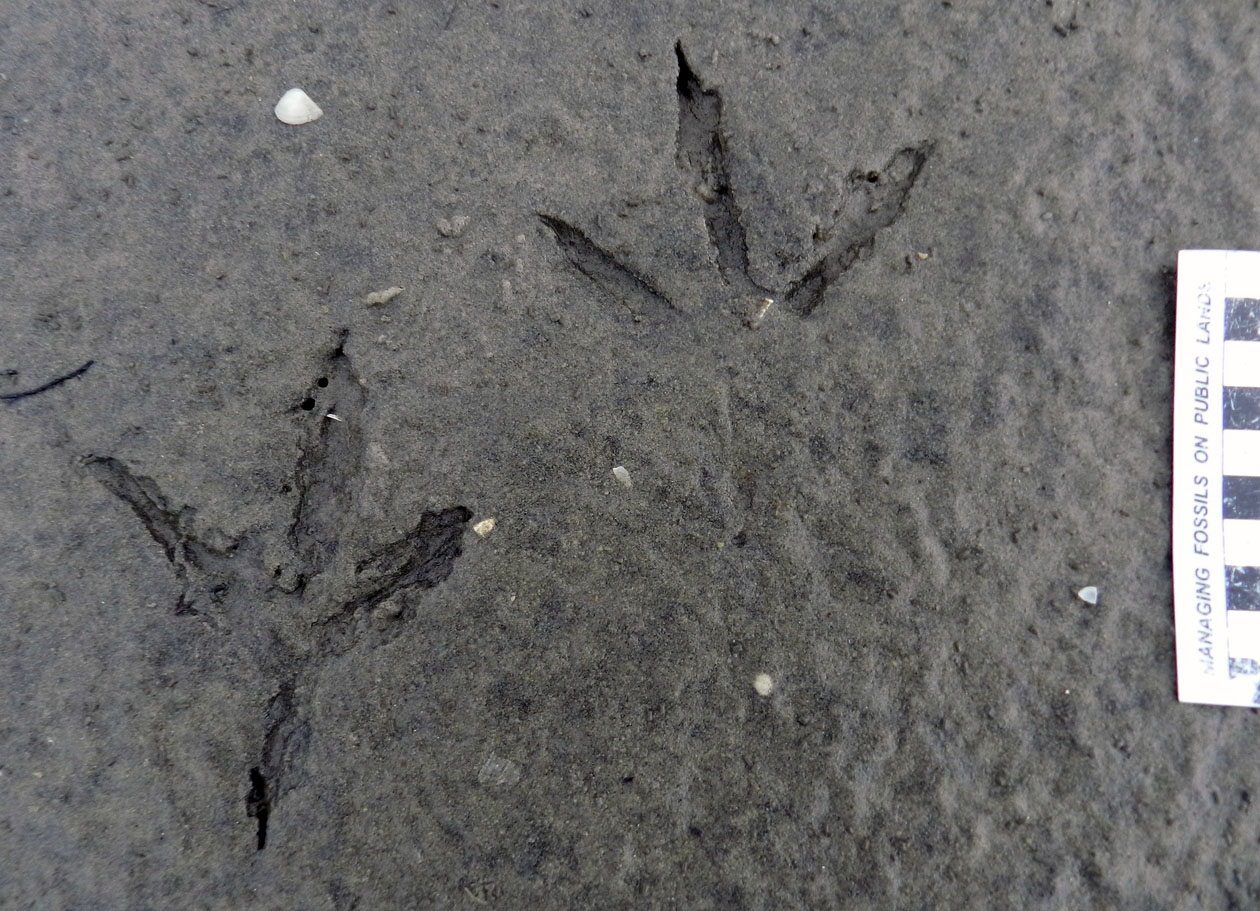 Close-up of landing tracks of a tricolored heron (Egretta tricolor) on a looser, moister, fine-grained sand in the back-dune area of St. Catherines Island, Georgia. The substrate conditions for these tracks are much closer to original ones for the Victoria tracks than those of a hard-packed beach sand. Notice how the hallux claw impression in the left foot is longer than the one on the right foot, which only shows up as a dot. (Photograph by Anthony Martin, scale in centimeters.)
Close-up of landing tracks of a tricolored heron (Egretta tricolor) on a looser, moister, fine-grained sand in the back-dune area of St. Catherines Island, Georgia. The substrate conditions for these tracks are much closer to original ones for the Victoria tracks than those of a hard-packed beach sand. Notice how the hallux claw impression in the left foot is longer than the one on the right foot, which only shows up as a dot. (Photograph by Anthony Martin, scale in centimeters.)
I described bird-flight tracks in my book Life Traces of the Georgia Coast (pages 386-391) in a section where I advised paleontologically inclined readers to apply and test these criteria with fossil bird tracks. But with these tracks from Victoria, I was unexpectedly following my own advice, a situation that encourages uncomfortable feelings in scientists who tend to be overly self-critical of their work (guilty as charged).
Moreover, at the time I was looking at these and the other two tracks (July 2011), my book had not been published yet, nor had I ever written or published any peer-reviewed paper on bird tracks. Sure, I’m an example of what Malcolm Gladwell wrote about in his book Blink, an expert who had a minimum of 10,000 hours of field experience backing up my intuition (a number that, quite frankly, he must have pulled out of his cloaca). Backing up this intuitive and experience-based conclusion, however, posed a huge challenge, like a fledgling trying to decide whether it was time to leave its nest and take a test flight. It’s not the ill effects of possible free-fall to fear, but the predators waiting to pounce on an avian-ichnological novice like myself.
Frustratingly, though, the rock holding these tracks lacked any other evidence of that next step, as well as the other foot. The track was of the bird’s right foot. As seen in the previous photos, volichnia made by landing birds have paired footprints, right and left together but slightly offset, and with either the right or left foot behind the other. But the slab of rock had no track behind this right-foot impression, and it was broken along the front edge of the middle digit. If this bird had landed with the right foot first – which I think it did – then the left foot would have been more than a track length ahead of the right. If so, it may be gone forever, taken by the same coastal erosion of the Victoria coast that gave its discoverers the surviving tracks, who arrived just in time to save them.
How were these tracks found? Not by me, that’s for sure. They were discovered by the invaluable, indispensable, and intrepid allies of desk-bound, exam-grading, lab-teaching, and meeting-imprisoned paleontologists everywhere: volunteers. On November 29, 2010 – almost three years ago – Museum Victoria volunteers Sean Wright and Alan Tait were at Dinosaur Cove, scouting for bones along its rugged, rocky shore. The name for this place was not bestowed on it because it resembled a Stegosaurus or some other pareidolia, but because it was the same place where most of the dinosaur bones known in Australia were found and recovered.
Excavated during the 1980s-1990s, Dinosaur Cove – which is about a three-hour drive west of Melbourne – was among the most logistically difficult dinosaur dig-sites in the world, as described by Tom Rich and Patricia (Pat) Vickers-Rich in their book, Dinosaurs of Darkness (2000, Indiana University Press). It and another site about a two-hour drive east of Melbourne, Dinosaur Dreaming, have resulted in the most complete assemblage of polar-dinosaur bones in the Southern Hemisphere.
Thus Wright and Tait were not searching randomly along the coast, but were looking for rocks that might contain fossil bones that had eroded out of the coastal outcrop. Instead of bones, though, Wright spotted the three-toed patterns of fossil tracks in a slab of rock amongst the boulders and cobbles in the surf zone. With this discovery, Dinosaur Cove was suddenly and inadvertently added to a very short list of Cretaceous vertebrate tracksites in southern Australia.
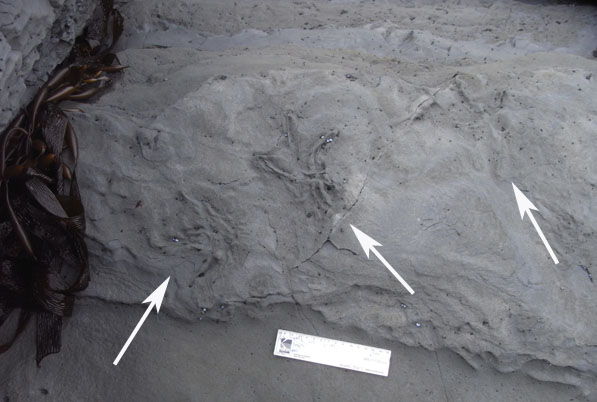 The slab of rock with the oldest known bird tracks in Australia. The two on the right we diagnosed as from birds, whereas the one on the left is probably a mere non-avian theropod track. (Photograph by Alan Tait.)
The slab of rock with the oldest known bird tracks in Australia. The two on the right we diagnosed as from birds, whereas the one on the left is probably a mere non-avian theropod track. (Photograph by Alan Tait.)
At the time, Wright and Tait figured these were probably fossil footprints of dinosaurs, such as theropods or ornithopods, both of which make three-toed tracks. When Tom e-mailed me photos of the tracks, I confirmed that they were tracks, and that they looked a lot like the theropod-dinosaur tracks I had described from rocks of the same age from Milanesia Beach, about 9 kilometers ( 5.5 miles) east of Dinosaur Cove.
About four months later, on March 31, 2011, Tait went back to Dinosaur Cove with some hand tools and a backpack, and broke the slab into four large pieces so they could be transported on foot: which he did, and with all 45 kg (100 lbs) on his back. For anyone who has hiked into and out of Dinosaur Cove – which I have several times – this was a remarkable one-person recovery effort, one that some people might term as “crazy.” But this craziness paid off big time.
The bird tracks had also come in for a landing a second time on the rocky shore of Dinosaur Cove, having fallen off the outcrop as a consequence of coastal erosion. Tom recognized the rock as coming from a sandstone bed just above the Slippery Rocks Tunnel site, where he, Pat, and many volunteers dug, broke, blasted, sifted, cursed, and otherwise labored in their quest to collect the dinosaurs there.
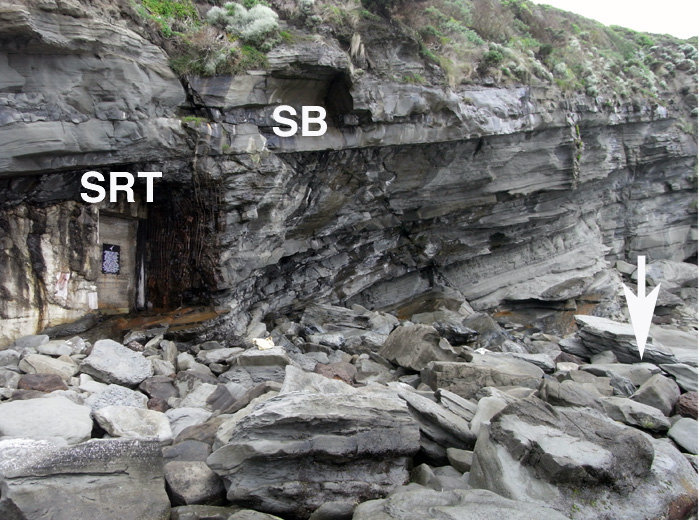 The Slippery Rocks Tunnel (SRT) site, where what was originally the greatest number of polar dinosaur bones in the Southern Hemisphere were found in the 1980s-1990s. The arrow shows where the slab holding the tracks was located until Alan Tait took it out of there and to Museum Victoria. The probable source bed (SB) for the tracks is just above the tunnel. (Photograph by Alan Tait, taken on November 29, 2010, the day the tracks were discovered.)
The Slippery Rocks Tunnel (SRT) site, where what was originally the greatest number of polar dinosaur bones in the Southern Hemisphere were found in the 1980s-1990s. The arrow shows where the slab holding the tracks was located until Alan Tait took it out of there and to Museum Victoria. The probable source bed (SB) for the tracks is just above the tunnel. (Photograph by Alan Tait, taken on November 29, 2010, the day the tracks were discovered.)
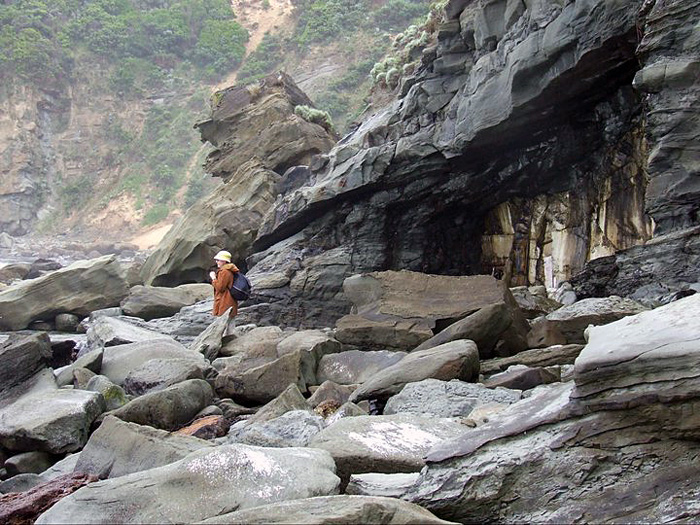 Another look at where the tracks were discovered, but from the other direction (looking west). I’m not sure if that’s Alan Tait in the photo and it was taken by Sean Wright, or whether it’s Sean Wright and the photo was taken by Alan Tait. Anyway, check out all of those Cretaceous rocks!
Another look at where the tracks were discovered, but from the other direction (looking west). I’m not sure if that’s Alan Tait in the photo and it was taken by Sean Wright, or whether it’s Sean Wright and the photo was taken by Alan Tait. Anyway, check out all of those Cretaceous rocks!
Great discovery, huh? Obviously, it was time for us to contact the press and breathlessly report that we had the oldest bird tracks in Australia. Except that, no, that would have been totally wrong, and would have served as a great example of how science is not done. This had to go through peer review, which meant that no matter how confident I might have been about their identity, they’re being described in a peer-reviewed publication and acceptance by the rest of the paleontological world was not guaranteed. So I asked Pat Vickers-Rich and Tom Rich to coauthor it, and was delighted when they accepted; sedimentologist Mike Hall of Monash University later joined us as a co-author, too.
 The broken slab of rock found by Sean Wright and Alan Tait at Dinosaur Cove, then taken out of there by Alan Tait, but now in its final resting place, the basement of Museum Victoria in Melbourne, where it’s been given a specimen number. Tracks ! and 2 (T1 and T2) are interpreted as bird tracks, whereas the one on the far left (T3) is probably a non-avian theropod dinosaur track. The arrow shows where the rock was sampled for describing the nature of the original sediments. What do I really love about this discovery? That the theropod-dinosaur track is the ho-hum and so-what part of it. Take that, non-avian theropods! Birds rule!
The broken slab of rock found by Sean Wright and Alan Tait at Dinosaur Cove, then taken out of there by Alan Tait, but now in its final resting place, the basement of Museum Victoria in Melbourne, where it’s been given a specimen number. Tracks ! and 2 (T1 and T2) are interpreted as bird tracks, whereas the one on the far left (T3) is probably a non-avian theropod dinosaur track. The arrow shows where the rock was sampled for describing the nature of the original sediments. What do I really love about this discovery? That the theropod-dinosaur track is the ho-hum and so-what part of it. Take that, non-avian theropods! Birds rule!
To make an already long story much brief, a year-and-a-half went by before the paper was finally accepted and published in the journal Palaeontology last Friday. Peer review on this paper was tough, and among the most challenging I’ve faced in my career. Different versions of the paper went through two rounds of review with four different reviewers, two of whom were anonymous, and two of whom were not (thank you, Matteo Belvedere and Jenni Scott!). I almost gave up on it several times, having been so discouraged by negative comments that I overlooked the most affirming part, which was this: all of the reviewers agreed we had bird tracks, and that they were the oldest known in Australia. That kept me going.
Notice I said “tracks,” as in plural. A great benefit of the sometimes-demoralizing scrutiny provided by these reviewers was that most pointed to the track just left of the “landing” track and said, there’s another one. Although I originally thought it was from a non-avian theropod, they were correct: this was from a bird’s left foot, and one with a foot close in size and form to the other one, although it had a much less obvious hallux impression. One of the more interesting traits of this track, too, was how one of its digits flexed as the foot moved against the sand, leaving a curved impression.
Close-up of the other large bird track on the same surface and close to the first one. Although I don’t think this one represents flight – just walking – it was the right anatomical traits for a bird, including that hallux impression on the lower right side. (Photography by Anthony Martin, scale in centimeters.)
The third track presented a dilemma, as it had qualities of a thin-toed non-avian theropod track – think something like an oviraptorid or ornithomimid – but easily could have been that of a bird, in which its hallux didn’t register on the sand at the time. So we concluded that it was probably from a non-avian theropod, but are open to the possibility that it was from a bird, too.
The third track on the slab, which we interpreted as the right footprint of a non-avian theropod dinosaur. It also probably represents a double print, where the foot registered twice and distorted its features a bit. This track is also very similar to theropod tracks identified from rocks of the same age at Milanesia Beach, which is about 9 km (5.5 mi) east from Dinosaur Cove on the Victoria coast. (Photograph by Anthony Martin, scale in centimeters.)
Could we all be wrong, and none of these tracks are from birds, but from some theropod dinosaurs that were very close to birds in their foot anatomy? Sure, that’s possible, but not likely at this point. Could I be wrong about taking one track and interpreting it as evidence of flight? Again, that’s possible. Alternate explanations include that the bird just hopped – perhaps with a flap or two – before landing. Or its foot just slipped on the wet sand as it was walking forward. However, in my experience with modern birds, such tracks are even more rare than volichnia. Could Cretaceous birds in polar Australia have been more clumsy than those today, hence their slipping tracks would have been more common? OK, now that’s just silly. Let’s just celebrate this find for what it is:
- The oldest known bird tracks in Australia.
- The only Early Cretaceous bird tracks in the Southern Hemisphere.
- The presence of fair-sized birds (herons or egrets) during the Early Cretaceous in a polar environment.
- Evidence for flight in an Early Cretaceous bird track, one of the few examples known in the world.
- The first vertebrate tracks known from Dinosaur Cove, a place previously famed for its dinosaur bones.
- The first dinosaur track from Dinosaur Cove.
- More evidence for Early Cretaceous birds in Australia to supplement the few bones that have been found thus far, including only a single furcula (wishbone) from Victoria.
All in all, it might just be three fossil tracks, but those three tracks just made the fossil record for the birds on an entire continent and the rest of the Southern Hemisphere just a little bit better. So now that they’ve landed, let’s allow our imaginations to take off, and go find some more.
Acknowledgments: My coauthors, Tom Rich, Pat Vickers-Rich, and Mike Hall; Sean Wright and Alan Tait; David Pickering and Rod Start at Museum Victoria; the Center for International Programs Abroad for transportation to and from Australia; my wife Ruth Schowalter for encouraging me during the 1.5 years of agonizing over the research; and of course, the tracemakers, avian and non-avian, who truly made the research possible by leaving tracks on that floodplain 105 million years ago.
Pertinent Links:
Martin, A.J., Vickers-Rich, P., Rich, T.H., and Hall, M. 2013. Oldest known avian footprints from Australia: Eumeralla Formation (Albian), Dinosaur Cove, Victoria. Palaeontology (published online October 25, 2013): DOI: 10.1111/pala.12082
ABC Science Show, October 26, 2013: “Fossilised Dino Bird Tracks 105 Million Years Old,” reported by Sharon Carleton.
Emory University Press Release (Eukekalert): “Tell-tale toes point to oldest-known fossil bird tracks from Australia.” (By Carol Clark, Emory University)

